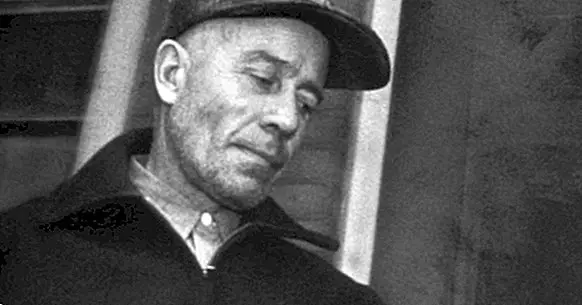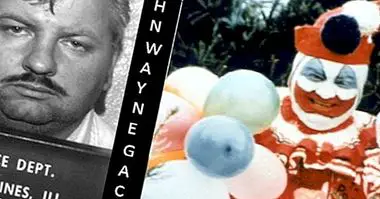Life and psychological portrait of Ed Gein, "the butcher of Plainfield" (2/2)
Read the first part of the story of Ed Gein: Life and psychological portrait of Ed Gein, the butcher of Plainfield (1/2)
(…)
The news about the disappearance of Mary Hogan It caused a great impact in the small town of Plainfield and was scattered throughout the surrounding villages. All the villagers speculated about what could have happened to him. The sawmill owner remembered seeing Ed Gein sitting at the back of the bar in Hogan's tavern, alone and absorbed in his thoughts, contemplating the owner with cold, expressionless eyes. He and many other neighbors who had talked with Ed, recalled how he often joked about the whereabouts of Mary Hogan with phrases such as "He has not disappeared ... In fact he is right now on my farm".
But none of these comments ever alarmed anyone, since they attributed it to another sample of the eccentric behavior of the farmer.
More murders in cold blood
On November 16, 1957, when the case was beginning to be forgotten, Ed Gein murdered the owner of a hardware store, Bernice Worden, shooting him in the head with a hunting rifle. In the same way as three years before, He dragged the body to the back of the place, carrying it in his van and taking it from there. But this time he made a mistake: Ed had come in with the excuse of buying anti-freeze fluid for his van and his name was listed in the store's ledger as the last customer.
While two police officers arrested Ed, two others went to search his farm and what they saw as they entered the tool shed froze their blood: the corpse of a woman hung upside down from pulleys, beheaded and naked . It had been opened in channel from the chest to the base of the abdomen and emptied inside. The guts were stuffed into a bag of esparto and another bag appeared Bernice Worden's head. It had hooks through its ears, ready to hang from the ceiling as a decoration.
The police notice the macabre acts of Ed Gein
While continuing to inspect the farm, in addition to a large accumulation of garbage and rubbish, they found a macabre spectacle: a collection of human skulls, some integers and others cut transversely to be used as bowls, masks made with human skin They decorated Ed Gein's room, as well as chairs and several garments made in the same way. There were boxes with human bones inside, and in the kitchen they found a pot boiling with Bernice Worden's heart in it. They also found Mary Hogan's head in one of the bags. The only room in the entire house that was intact was his mother's, which was sealed with wooden planks since he passed away.
Once at the police station, Ed admitted that he often felt the need to go to the cemetery and exhume the corpses of the dead women that reminded him of his mother, many of whom he had known in life. Sometimes he took the entire bodies, while other times simply those parts that interested him most. He said he had never had sex with bodies, because he said they "smelled bad".
Also, Ed Gein He recognized that many nights he heard his mother's voice before falling asleep and that in some way, he urged him to kill . According to this, according to the classification of Holmes and DeBurger (1988) of serial killers, would be part of the type of killer "visionary", which is one that kills moved by an obvious mental disorder. This disorder causes a person who has a break with reality and, due to delusions and hallucinations (most often of the auditory type), fulfills the orders to kill a type of people, who usually have some common characteristics among them. These mandates tend to come from beings from another world or from the devil himself, but also from beings who, for one reason or another, have exercised great control over the murderers, who come to perceive them as deities of undeniable authority.
The traumas of the butcher of Plainfeld
In this case, the feelings of love and hate that Ed had towards his mother led him to see her as someone who continued to have an enormous influence despite having been deceased for years. According to the sheriff, Mary Hogan and Bernice Worden were the type of women who embodied everything their mother detested, so by following the strict moral code she imposed on them, she murdered them to try to prevent them from continuing with her (he believed ) indecent sinful life.The accumulation of forensic evidence at the crime scene (the shotgun cartridge, traces of blood or marks on the snow of the van, not to mention everything found on your farm) would be another factor when considering Ed Gein within this typology.
However, it seems that there are elements that do not fit, since the visionary assassins usually abandon the weapon and the corpse in the same scene of the crime. Also, their victims are chosen at random and, as alleged by the witnesses and Ed Gein himself, he had been hanging around for some time.
There is an added element of great relevance in this story, and that Ed Gein's purpose in killing those women and unearthing the bodies of the cemetery was not only to revive his mother, but he wanted to become her: the confrontation of the Love that he felt, with the feelings of anger and frustration for denying him contact with women, mixed with a late and anomalous sexual development, caused that, when Augusta died, Ed Gein give free rein to fantasize about transsexuality . These ideas of sex change and his admiration for death and dismemberment was what led Ed Gein to make all those garments with the skin of his victims. Many nights she put on her clothes and walked around her house imitating the gestures and voice of Augusta, behaving as if she were still alive, sitting in her armchair, etc.
In the police interrogation he was administered the Weschler intelligence test, whose results reflected an intelligence within the mean, even going beyond it. But great difficulties were also detected in expressing and communicating. In addition to these conclusions, the psychologists of the hospital where he was hospitalized ruled that he suffered from an emotional disorder that led him to behave irrationally, combined with periods of lucidity during which he felt remorse for the crimes he had accumulated in his record.
Internment and death
Ed Gein entered the Mendota nursery in 1958 for an indefinite period, a decision that did not please the relatives of the victims, who asked for a trial that never came to be held. After becoming a model inmate, standing out for his good behavior both with guards and with the rest of the interns, as well as carrying out tasks and several jobs that earned him a good reputation, in 1974 he asked for his freedom. The judge in charge of the case requested that a second report be carried out by four psychologists, who unanimously determined that Gein should remain confined.
Ed Gein died of respiratory failure on July 26, 1984 at the Geriatric Hospital for the Mentally Ill in Mendota. From the life of Ed Gein we can draw certain conclusions about the risk factors that led his criminal life to the point of being listed as a serial killer:
- His origin of a dysfunctional home, with a family history of parental neglect, abuse of alcohol and abuse, among others, was the first component that made possible the development of his psychopathic and violent personality.
- Secondly, the social isolation suffered during adolescence incapacitated him from engaging in the necessary social relationships during this period and thus being able to connect emotionally with people.
- And finally, the withdrawal and loneliness that led to the generation of fantasies and the development of antisocial behavior, based on the belief that the world is a hostile place. The more lonely Ed Gein became, the more he grew dependent on his fantasies. Over time, these fantasies became more violent and twisted.



















